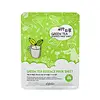What's inside
What's inside
 Key Ingredients
Key Ingredients

 Benefits
Benefits

 Concerns
Concerns

 Ingredients Side-by-side
Ingredients Side-by-side

Water
Skin ConditioningStearic Acid
CleansingNeopentyl Glycol Diheptanoate
EmollientCetearyl Olivate
Sorbitan Olivate
EmulsifyingHydrogenated Poly(C6-14 Olefin)
EmollientGlycerin
HumectantCyclomethicone
EmollientButylene Glycol
HumectantCopper Tripeptide-1
Skin ConditioningGlyceryl Stearate
EmollientPEG-100 Stearate
Polyacrylate-13
Polyisobutene
Polysorbate 20
EmulsifyingCetearyl Alcohol
EmollientCetearyl Glucoside
EmulsifyingDimethicone
EmollientTrehalose
HumectantTheobroma Cacao Extract
Skin ConditioningCaprylyl Glycol
EmollientAmmonium Acryloyldimethyltaurate/Vp Copolymer
Triethanolamine
BufferingCoptis Japonica Extract
AntimicrobialAdenosine
Skin ConditioningPropylene Glycol
HumectantHydrolyzed Extensin
Skin ConditioningRubus Idaeus Fruit Extract
AstringentBeta-Glucan
Skin ConditioningBiosaccharide Gum-1
HumectantIris Ensata Extract
Skin ConditioningHydrolyzed Wheat Protein
Skin ConditioningPrunus Amygdalus Dulcis Seed Extract
Skin ConditioningLavandula Angustifolia Oil
MaskingDisodium EDTA
Water, Stearic Acid, Neopentyl Glycol Diheptanoate, Cetearyl Olivate, Sorbitan Olivate, Hydrogenated Poly(C6-14 Olefin), Glycerin, Cyclomethicone, Butylene Glycol, Copper Tripeptide-1, Glyceryl Stearate, PEG-100 Stearate, Polyacrylate-13, Polyisobutene, Polysorbate 20, Cetearyl Alcohol, Cetearyl Glucoside, Dimethicone, Trehalose, Theobroma Cacao Extract, Caprylyl Glycol, Ammonium Acryloyldimethyltaurate/Vp Copolymer, Triethanolamine, Coptis Japonica Extract, Adenosine, Propylene Glycol, Hydrolyzed Extensin, Rubus Idaeus Fruit Extract, Beta-Glucan, Biosaccharide Gum-1, Iris Ensata Extract, Hydrolyzed Wheat Protein, Prunus Amygdalus Dulcis Seed Extract, Lavandula Angustifolia Oil, Disodium EDTA
 Reviews
Reviews

Ingredients Explained
These ingredients are found in both products.
Ingredients higher up in an ingredient list are typically present in a larger amount.
Glycerin is already naturally found in your skin. It helps moisturize and protect your skin.
A study from 2016 found glycerin to be more effective as a humectant than AHAs and hyaluronic acid.
As a humectant, it helps the skin stay hydrated by pulling moisture to your skin. The low molecular weight of glycerin allows it to pull moisture into the deeper layers of your skin.
Hydrated skin improves your skin barrier; Your skin barrier helps protect against irritants and bacteria.
Glycerin has also been found to have antimicrobial and antiviral properties. Due to these properties, glycerin is often used in wound and burn treatments.
In cosmetics, glycerin is usually derived from plants such as soybean or palm. However, it can also be sourced from animals, such as tallow or animal fat.
This ingredient is organic, colorless, odorless, and non-toxic.
Glycerin is the name for this ingredient in American English. British English uses Glycerol/Glycerine.
Learn more about GlycerinPropylene Glycol is an odorless, colorless liquid. As a humectant, it helps skin retain moisture. It also aids in delivering active ingredients.
Another role of this ingredient is preventing a product from melting or freezing. Propylene glycol also adds antimicrobrial properties to a product, elongating product lifespan.
This ingredient is considered an organic alcohol and commonly added into both cosmetics and foods.
Those with sensitive skin or conditions may develop a rash when using this ingredient.
Learn more about Propylene GlycolTriethanolamine is an emulsifier and pH adjuster. It is created using ethylene oxide and ammonia. This gives Triethanolamine a nitrogen core and a similar scent to ammonia.
As an emulsifier, it prevents ingredients from separating and enhances texture by adding volume to a product.
PH adjusters are common in cosmetic products. The pH of a product can affect the effectiveness of other ingredients. A product with a high pH may also irritate the skin.
Learn more about TriethanolamineWater. It's the most common cosmetic ingredient of all. You'll usually see it at the top of ingredient lists, meaning that it makes up the largest part of the product.
So why is it so popular? Water most often acts as a solvent - this means that it helps dissolve other ingredients into the formulation.
You'll also recognize water as that liquid we all need to stay alive. If you see this, drink a glass of water. Stay hydrated!
Learn more about Water